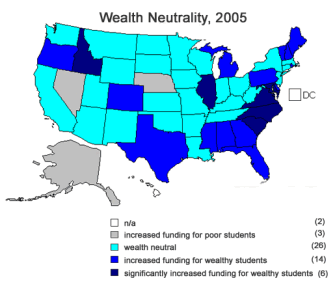The majority of local school funding is determined by property taxes; thus, school districts in wealthier areas are traditionally able to raise more funds than schools in poorer areas. Because some scholars and policy makers believe that the amount of money spent per student is tied to academic achievement, many states have made efforts to make their school funding wealth neutral. They increase the amount of state aid to students in poorer districts to meet the same level of funding as wealthy districts are able to provide locally. The EPE Research Center calculated wealth neutrality in Quality Counts 2008, an index based on the correlation between units of wealth and total spending per student, finding that 26 states in 2005 were reasonably wealth neutral. This means that in half the states approximately the same amount of money was spent on students in poorer districts as students in wealthier districts. Three states funded poorer districts considerably more than wealthy districts and 20 states did not have school districts that were wealth neutral. Hawaii and the District of Columbia are single school district jurisdictions, so it was not possible to calculate the index.
For more information on wealth neutrality and other state-by-state data, search EPE’s Education Counts database.
SOURCE: EPE Research Center, 2008.

